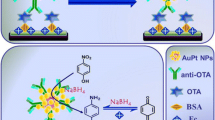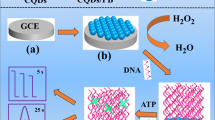Abstract
Pb(II) can accumulate in the body and gradually cause irreversible harm. In this work, a dual-mode colorimetric biosensor based on an aptamer was developed as an effective method for sensitive sensing of Pb(II). The aptamers were immobilized on silver nanoparticles (Ag NPs) by Ag–S bonding to increase the active sites on the electrode surface. Gold–palladium bimetallic nanoparticles (Au@Pd NPs) can not only serve as signal indicators but also play a role as nanozymes. On the one hand, Au@Pd NPs were modified on the aptamer to improve the conductivity of the sensor for the detection of Pb(II) by the electrochemical method of differential pulse voltammetry (DPV). On the other hand, Au@Pd NPs were porous nanomaterials with numerous active sites on their surface that can catalyze the decomposition of hydrogen peroxide (H2O2) in solution to generate O2, so that 3,3′,5,5′-tetramethylbenzidine (TMB) was oxidized to blue oxTMB, enabling the visual prediction of Pb(II). At the same time, with the property that 8–17 deoxyribozyme and metal ions can co-catalyze, it promoted the binding of Au@Pd NPs functionalized aptamer to the electrode in the presence of Pb(II) and enhanced the electrochemical signal. Under optimal conditions, the detection range of Pb(II) was 1—1000 nmol L−1, and the limit of detection (LOD) was 0.4 nmol L−1. The biosensor has been successfully applied to the detection of edible mushroom samples.
Graphical abstract







Similar content being viewed by others
References
Zhang J, Barałkiewicz D, Hanć A, Falandysz J, Wang YZ (2020) Contents and health risk assessment of elements in three edible ectomycorrhizal fungi (Boletaceae) from polymetallic soils in Yunnan Province, SW China. Biol Trace Elem Res 195:250–259. https://doi.org/10.1007/s12011-019-01843-y
Kokkoris V, Massas I, Polemis E, Koutrotsios G, Zervakis GI (2019) Accumulation of heavy metals by wild edible mushrooms with respect to soil substrates in the Athens metropolitan area (Greece). Sci Total Environ 685:280–296. https://doi.org/10.1016/j.scitotenv.2019.05.447
Zhou XS, Gai ZG, Wang YB, Liu SS, Zhang XY, Guo FX, Zhang M, Zhang LL, Jiang X (2023) High performance ratiometric detection towards trace Cd(II) and Pb(II) utilizing in-situ bismuth modified nitrogen rich porous carbon/boron doped diamond composite electrode. J Environ Chem Eng 11(2):109448. https://doi.org/10.1016/j.jece.2023.109448
Tümay SO, Şenocak A, Sarı E, Şanko V, Durmuş M, Demirbas E (2021) A new perspective for electrochemical determination of parathion and chlorantraniliprole pesticides via carbon nanotube-based thiophene-ferrocene appended hybrid nanosensor. Sens Actuators B Chem 345:130344. https://doi.org/10.1016/j.snb.2021.130344
Narayanan M, Amalraj A, Perumal P (2023) A copper oxide functionalized neodymium oxide hybrid nanostructure interconnected with modified glassy carbon electrode (CuO–Nd2O3/GCE) for electrochemical determination of Malathion pesticide. J Mater Res 38:416–428. https://doi.org/10.1557/s43578-022-00826-5
Narayanan M, Amalraj A, Perumal P (2022) Highly efficient peroxidase-like activity of a metal–oxide-incorporated CeO2-MIL(Fe) metal-organic framework and its application in the colorimetric detection of melamine and mercury ions via induced hydrogen and covalent bonds. Analyst 147:3234–3247. https://doi.org/10.1039/D2AN00864E
Huang PP, Chang Q, Jiang GD, Wang X, Zhu HP, Liu QQ (2022) Rapidly and ultra-sensitive colorimetric detection of H2O2 and glucose based on ferrous-metal organic framework with enhanced peroxidase-mimicking activity. Spectrochimica Acta A Mol Biomol Spectrosc 121943:1386–1425. https://doi.org/10.1016/j.saa.2022.121943
Khawaji M, Chadwick D (2020) Selective oxidation using Au-Pd catalysts: Role of the support in the stabilization of colloidal Au-Pd NPs. Catal Today 348:203–211. https://doi.org/10.1016/j.cattod.2019.08.036
Komkova MA, Zarochintsev AA, Karyakin AA (2022) Nanozymes ‘artificial peroxidase’ in reduction and detection of organic peroxides. J Electroanal Chem 904:115902. https://doi.org/10.1016/j.jelechem.2021.115902
Vokhmyanina DV, Andreeva KD, Komkova MA, Karyakina EE, Karyakin AA (2020) ‘Artificial peroxidase’ nanozyme-enzyme based lactate biosensor. Talanta 208:120393. https://doi.org/10.1016/j.talanta.2019.120393
Wang JN, Zeng MQ, Zhao YH, Zuo XX, Meng FR, Jie HY, Lv F, Lu Y, Hou JB (2022) Synergetic integration of catalase and Fe3O4 magnetic nanoparticles with metal organic framework for colorimetric detection of phenol. Environ Res 206:112580. https://doi.org/10.1016/j.envres.2021.112580
Nguyen TTQ, Kim ER, Gu MB (2022) A new cognate aptamer pair-based sandwich-type electrochemical biosensor for sensitive detection of Staphylococcus aureus. Biosens Bioelectron 198:113835. https://doi.org/10.1016/j.bios.2021.113835
Ying X, Li W, Wen Q, Xu D, Ren JL, Lin QL (2021) Aptamer-engineered nanomaterials to aid in mycotoxin determination. Food Control. https://doi.org/10.1016/j.foodcont.2021.108661
Shirani M, Kalantari H, Khodayar MJ, Kouchak M, Rahbar N (2020) A novel strategy for detection of small molecules based on aptamer/gold nanoparticles/graphitic carbon nitride nanosheets as fluorescent biosensor. Talanta 219:121235. https://doi.org/10.1016/j.talanta.2020.121235
Wang RR, Cao Y, Qu H, Wang YB, Zheng L (2022) Label-free detection of Cu(II) in fish using a graphene field-effect transistor gated by structure-switching aptamer probes. Talanta 237:122965. https://doi.org/10.1016/j.talanta.2021.122965
Liang G, Man Y, Li A, Jin XX, Liu XH, Pan LG (2017) DNAzyme-based biosensor for detection of lead ion: a review. Microchem J 131:145–153. https://doi.org/10.1016/j.microc.2016.12.010
Tan Y, Qiu JZ, Cui MY, Wei XF, Zhao MM, Qiu B, Chen GN (2016) An immobilization free DNAzyme based electrochemical biosensor for lead determination. Analyst 141:1121–1126. https://doi.org/10.1039/C5AN02114F
Yu YJ, Yu C, Niu YZ, Chen J, Zhao YL, Zhang YC, Gao RF, He JL (2018) Target triggered cleavage effect of DNAzyme: Relying on Pd-Pt alloys functionalized Fe-MOFs for amplified detection of Pb2+. Biosens Bioelectron 101:297–303. https://doi.org/10.1016/j.bios.2017.10.006
Zhou Q, Lin YX, Lin YP, Wei QH, Chen GN, Tang DP (2016) Highly sensitive electrochemical sensing platform for lead ion based on synergetic catalysis of DNAzyme and Au-Pd porous bimetallic nanostructures. Biosens Bioelectron 78:236–243. https://doi.org/10.1016/j.bios.2015.11.055
Song XL, Wang Y, Liu S, Zhang X, Wang JF, Wang HW, Zhang FF, Yu JH, Huang JD (2019) A triply amplified electrochemical lead(II) sensor by using a DNAzyme and via formation of a DNA-gold nanoparticle network induced by a catalytic hairpin assembly. Microchim Acta 186:559. https://doi.org/10.1007/s00604-019-3612-5
Mandal R, Baranwal A, Srivastava A, Chandra P (2018) Evolving trends in bio/chemical sensor fabrication incorporating bimetallic nanoparticles. Biosens Bioelectron 117:546–561. https://doi.org/10.1016/j.bios.2018.06.039
Sun HY, Chen SJ, Yang WJ, Wang LZ, Tang R, Zhang XM, Zheng RK, Gu SS, Jiang YJ, Liang WB, Huang J (2021) Plasmon-enhanced alcohol oxidations over porous carbon nanosphere-supported palladium and gold bimetallic nanocatalyst. Appl Catal B 292:120151. https://doi.org/10.1016/j.apcatb.2021.120151
Li SS, Wang AJ, Hu YY, Fang KM, Chen JR, Feng JJ (2014) One-step, seedless wet-chemical synthesis of gold@palladium nanoflowers supported on reduced graphene oxide with enhanced electrocatalytic properties. J Mater Chem A 2:18177–18183. https://doi.org/10.1039/C4TA04164J
Li RY, Yang TT, Li ZJ, Gu ZG, Wang GL, Liu JK (2017) Synthesis of palladium@gold nanoalloys/nitrogen and sulphur-functionalized multiple graphene aerogel for electrochemical detection of dopamine. Anal Chim Acta 954:43–51. https://doi.org/10.1016/j.aca.2016.12.031
Zhou HF, Chen LM, Li ST, Huang SQ, Sun YY, Chen YH, Wang Z, Liu W, Li XC (2020) One-step electroreduction preparation of multilayered reduced graphene oxide/gold-palladium nanohybrid as a proficient electrocatalyst for development of sensitive hydrazine sensor. J Colloid Interface Sci 566:473–484. https://doi.org/10.1016/j.jcis.2020.01.105
Velpula S, Beedu S, Rupula K (2021) Bimetallic nanocomposite (Ag-Au, Ag-Pd, Au-Pd) synthesis using gum kondagogu a natural biopolymer and their catalytic potentials in the degradation of 4-nitrophenol. Int J Biol Macromol. https://doi.org/10.1016/j.ijbiomac.2021.08.211
Taghdisi SM, Noor MD, Parirokh L, Mohammad R, Khalil A (2016) An electrochemical aptasensor based on gold nanoparticles, thionine and hairpin structure of complementary strand of aptamer for ultrasensitive detection of lead. Sens Actuators B Chem 234:462–469. https://doi.org/10.1016/j.snb.2016.05.017
Zheng Y, Wang XY, He SQ, Gao ZH, Di Y, Lu KL, Li K, Wang JD (2019) Aptamer-DNA concatamer-quantum dots based electrochemical biosensing strategy for green and ultrasensitive detection of tumor cells via mercury-free anodic stripping voltammetry. Biosens Bioelectron 126:261–268. https://doi.org/10.1016/j.bios.2018.09.076
Wang LY, Peng XL, Fu HJ (2022) An electrochemical aptasensor for the sensitive detection of Pb2+ based on a chitosan/reduced graphene oxide/titanium dioxide. Microchem J 174:106977. https://doi.org/10.1016/j.microc.2021.106977
Ma JP, Bai WS, Zheng JB (2022) A novel self-cleaning electrochemical biosensor integrating copper porphyrin-derived metal-organic framework nanofilms, G-quadruplex, and DNA nanomotors for achieving cyclic detection of lead ions. Biosens Bioelectron 197:113801. https://doi.org/10.1016/j.bios.2021.113801
Fu T, Ren SL, Gong L, Meng HM, Cui L, Kong RM, Zhang XB, Tan WH (2016) A label-free DNAzyme fluorescence biosensor for amplified detection of Pb2+-based on cleavage-induced G-quadruplex formation. Talanta 147:302–306. https://doi.org/10.1016/j.talanta.2015.10.004
Zhang Q, Cai Y, Li H, Kong DM, Shen HX (2012) Sensitive dual DNAzymes-based sensors designed by grafting self-blocked G-quadruplex DNAzymes to the substrates of metal ion-triggered DNA/RNA-cleaving DNAzymes. Biosens Bioelectron 38:331–336. https://doi.org/10.1016/j.bios.2012.06.011
Zhu Q, Liu LH, Xing YP, Zhou XH (2018) Duplex functional G-quadruplex/NMM fluorescent probe for label-free detection of lead(II) and mercury(II) ions. J Hazard Mater 355:50–55. https://doi.org/10.1016/j.jhazmat.2018.04.082
Acknowledgements
This work was supported by the Natural Science Foundation-PhD of Shandong Province (ZR2018BC055) for research on the mechanism and analysis method of biosensor based Pb(II) detection in edible mushrooms.
Funding
Natural Science Foundation of Shandong Province, ZR2018BC055.
Author information
Authors and Affiliations
Contributions
QG: Conceptualization, Methodology, Writing-original draft. JY: Methodology, Writing-review & editing. YZ: Investigation, Writing-review & editing. YW: Validation. HZ: Validation. LY: Validation, Investigation. MT: Resources, Writing-review & editing. XS: Formal analysis. YG: Formal analysis. YZ: Supervision, Funding acquisition.
Corresponding author
Ethics declarations
Conflict of interest
The authors declare no competing interests.
Additional information
Publisher's Note
Springer Nature remains neutral with regard to jurisdictional claims in published maps and institutional affiliations.
Supplementary Information
Below is the link to the electronic supplementary material.
Rights and permissions
Springer Nature or its licensor (e.g. a society or other partner) holds exclusive rights to this article under a publishing agreement with the author(s) or other rightsholder(s); author self-archiving of the accepted manuscript version of this article is solely governed by the terms of such publishing agreement and applicable law.
About this article
Cite this article
Guo, Q., Yin, J., Zhang, Y. et al. Dual-mode colorimetric electrochemical aptamer sensor based on Au@Pd bimetallic nanoparticles for the detection of Pb(II) in edible mushrooms. J Appl Electrochem (2024). https://doi.org/10.1007/s10800-024-02070-7
Received:
Accepted:
Published:
DOI: https://doi.org/10.1007/s10800-024-02070-7




